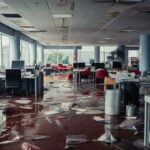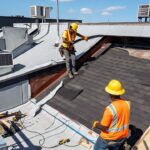Are you planning to install a commercial roof? If you’re a new property owner or have invested in buildings like warehouses or apartments, there’s a lot to learn. Understanding insurance, HVAC systems, and roofing is crucial, and the learning curve can be steep.
One key area that often gets overlooked is your roof. Choosing the right material and knowing the installation process is vital. This protects your investment and ensures long-term durability.
That’s where we come in. This quick guide gives you a basic understanding of common commercial roofing materials and installation. Whether you’re replacing a roof or managing a new build, knowing your options helps you make informed choices. With the right knowledge, you can ensure your commercial roof is installed correctly, lasts longer, and saves you money in the long run.
Seven Commonly Installed Commercial Roofing Systems
-
Built-Up Roofing (BUR)
Also known as “tar and gravel” roofs, BUR systems consist of multiple layers of bitumen and reinforcing fabrics. They’re known for durability and excellent waterproofing. -
Modified Bitumen Roofing
A variation of BUR, this system uses asphalt reinforced with polymers for added strength and flexibility. It’s often used in low-slope applications. -
EPDM Roofing (Ethylene Propylene Diene Monomer)
This synthetic rubber membrane is popular for its affordability, weather resistance, and long lifespan. It’s easy to install and maintain. -
TPO Roofing (Thermoplastic Olefin)
Known for energy efficiency and heat-reflective properties, TPO roofs are durable, cost-effective, and increasingly popular in commercial settings. -
PVC Roofing (Polyvinyl Chloride)
PVC roofing offers excellent chemical resistance, making it ideal for restaurants and industrial buildings. It’s also fire-resistant and long-lasting. -
Metal Roofing
Extremely durable and resistant to extreme weather, metal roofs come in a variety of styles and are often used on sloped commercial roofs. -
Green Roofing Systems
These environmentally friendly roofs are covered in vegetation and soil, offering insulation, reducing stormwater runoff, and improving air quality.
Commercial Roofs Require Professional Maintenance
Knowing the basics of popular commercial roofing systems is crucial. Flat roofs need regular inspections to stay in good shape. Routine maintenance helps you catch problems early. This can prevent costly roof replacements down the line.
Applying a roof coating is a smart choice. It extends your roof’s life and improves your building’s energy efficiency. A reflective coating keeps your interior cooler. This reduces the load on your HVAC system, easing your worries.
Staying proactive with inspections and maintenance protects your investment. It also maximizes performance and energy savings.
Read More: Water Damage Restoration Akron, Oh



